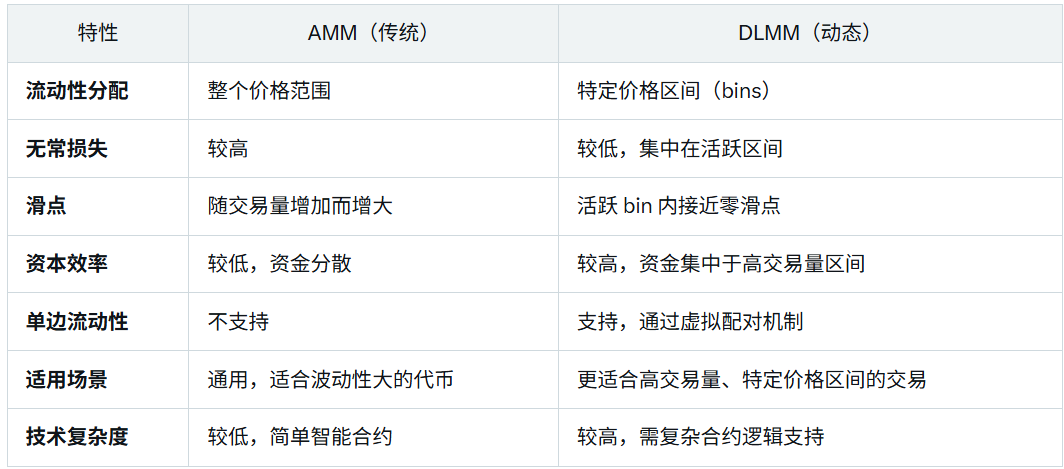Saros 2.0 is more than just a DEX, it's a full-stack liquidity engine that redefines liquidity standards on Solana by providing users and liquidity providers (LPs) with efficient, transparent, and composable composable infrastructure.
What are the features of Saros 2.0
1Uses DLMM (Dynamic Liquidity Market Maker) mechanism
2. Full-stack design
Saros 2.0 isn't just a DLMM DEX, it's still
Token Factory & Launchpad, anyone can issue coins and build pools in seconds without approval
Auto-Pool Engine for Memecoins, which automatically generates efficient liquidity pools for memes with one click
Spot + Perpetual Trading, where spot and perpetual contracts share a liquidity backend
Mobile Superapp Integration, mobile also has a one-stop experience
Saros 2.0 is building a new generation of Solana-native liquidity engine with full on-chain + autonomous strategy + full-stack integration as the core, meeting the rapid deployment and strategy freedom of meme, long-tail assets, high-frequency trading and other scenarios
DLMM vs. AMM: Liquidity Mechanism of Decentralized Exchanges
DLMM (Dynamic Liquidity Market Maker) and AMM (Automated Market Maker) are the core mechanisms used to provide liquidity in decentralized exchanges (DEXs). There are significant differences between the two in terms of design concepts, functional features, and technical implementation. This article will compare the working principles, advantages and disadvantages of the two, and the technical implementation of the two in detail.
1. The core types and characteristics of traditional AMMs
Traditional AMMs manage liquidity pools through smart contracts, replacing the traditional order book trading model. Depending on the function design, AMMs can be divided into the following main types:
1. Constant Product Market Maker (CPMM)
Representative projects: Uniswap, Bancor
How it works: Based on the formula x * y = k, where x and y are the reserves of the two tokens, coke, k are constants. The token price is determined by the proportion of tokens in the pool.
When the supply of token X increases, the supply of Y must decrease in order to keep k constant.
Merit:
Simple and efficient, users interact directly with liquidity pools, eliminating the need for order books.
Support trading of any token pair.
Shortcoming:
Impermanent Loss (IL): Liquidity Providers (LPs) may incur losses when prices fluctuate.
Capital efficiency is low, and liquidity is dispersed across the price range.
2. Constant and Market Maker (CSMM)
How it works: Fixed price, similar to a traditional fixed-price order.
Shortcoming:
Traders and arbitrageurs can deplete the reserves of a certain token in the pool, resulting in an imbalance in the liquidity pool.
Liquidity pools may be concentrated in a single asset and lose normal trading function.
3. Constant Average Market Maker (CMMM)
Representative project: Balancer
How it works: Multiple token combinations are allowed, the weights are adjustable, but still based on a CPMM-like function.
Shortcoming:
The problem of impermanent loss cannot be completely solved.
The complexity is high and suitable for specific scenarios.
4. Hybrid CPMM (Stableswap)
Representative Projects:
How it works: Combine CPMM and CSMM to optimize stablecoin transactions (e.g. USDT/DAI/USDC).
Advantages: Reduced slippage, suitable for assets with low price fluctuations.
Disadvantages: Limited to stablecoins or assets with highly correlated prices, cannot be widely used in highly volatile tokens.
2. DLMM: A new generation of market maker mechanism
DLMMs (such as Meteora on Solana) are an evolved version of AMMs that employ a centralized liquidity model that improves capital efficiency by allocating liquidity to specific price bands, known as "bins" or price slots. The following are the core features and technical implementations of DLMM:
1. How it works
Concentrated Liquidity:
LPs can choose to concentrate their funds in a certain price range (e.g., 0.95-1.05 USDC/SOL) instead of the entire price range.
Improve capital efficiency and reduce waste of unused funds.
Bins mechanism:
Each bin represents a fixed price range, and trades are executed at the price of that bin, similar to a limit order.
Example: The current bin price is 1 USDC/SOL, and a trader buys SOL with USDC at a fixed price until the bin's SOL reserves are exhausted.
When the bin liquidity is exhausted, the system automatically switches to the next bin (e.g., the price jumps to 1.01 USDC/SOL).
Dynamic Fees:
Dynamically adjust fees based on market volatility and trading volume to optimize LP earnings.
Unilateral Liquidity:
LPs can offer only one token (e.g., SOL), and smart contracts emulate token pairs from traditional AMMs through a "virtual pairing" mechanism.
Example:
Traders buy SOL with USDC: USDC goes into the pool, and SOL is spent from the bin's "virtual reserves".
A trader buys USDC with SOL: SOL goes into the pool, and USDC is spent from the bin's actual reserves.
2. Technical Implementation
Smart Contract Management:
Track the amount of token reserves for each bin in real-time.
Update the bin reserve according to the direction of the trade (buy/sell) and decide whether to switch to the next bin.
When switching bins, the contract triggers an event to notify the front-end or off-chain system to update the price.
On-chain order book experience:
Bins' scale price mechanism allows users to experience functions similar to the order book of a centralized exchange.
Dynamic Cost Calculation:
Smart contracts adjust transaction fees in real-time based on market conditions, balancing LP revenue with trader costs.
3. Pros
Reducing Impermanent Loss:
LPs only provide liquidity for a specific price range, and only a portion of the funds are affected when the price fluctuates significantly.
Zero slippage trading:
Trading within an active bin is executed at a fixed price with minimal to zero slippage.
High Capital Efficiency:
Liquidity is concentrated in the high-volume price range, and the utilization rate of funds is higher.
Flexibility:
Support unilateral liquidity and lower the threshold for LP participation.
Dynamic fee mechanism optimizes revenue.
4. Cons:
Liquidity depletion risk:
If the volume is unbalanced (e.g., one-way trading only), the liquidity of a bin may be depleted, resulting in trading halts or price jumps.
Contract Logic Complexity:
The virtual token reserve relies on smart contract logic, which requires a highly reliable contract design.
Technical Threshold:
Compared with traditional AMMs, the implementation and use of DLMM is more technically demanding for developers and LPs.
summary
Traditional AMMs (e.g., Uniswap, Balancer, Curve) enable decentralized trading through simple mathematical functions (e.g., x*y=k) and are suitable for a wide range of token pairs, but are limited by impermanent loss and low capital efficiency.
DLMMs, such as Meteora, significantly improve capital efficiency and LP yield through centralized liquidity, price bands (bins), zero-slippage trading, and dynamic fee mechanisms, while effectively reducing impermanent loss. Single-sided liquidity and an on-chain order book experience further enhance its flexibility.
Future Outlook: The complexity of DLMM and its reliance on volume balancing may limit its use in certain scenarios, but its innovative design provides DEXs with a more efficient liquidity solution, especially in high-volume markets. With the development of blockchain technology, DLMM is expected to be widely used on more chains (e.g., Solana, Ethereum L2).

5.42K
0
The content on this page is provided by third parties. Unless otherwise stated, OKX is not the author of the cited article(s) and does not claim any copyright in the materials. The content is provided for informational purposes only and does not represent the views of OKX. It is not intended to be an endorsement of any kind and should not be considered investment advice or a solicitation to buy or sell digital assets. To the extent generative AI is utilized to provide summaries or other information, such AI generated content may be inaccurate or inconsistent. Please read the linked article for more details and information. OKX is not responsible for content hosted on third party sites. Digital asset holdings, including stablecoins and NFTs, involve a high degree of risk and can fluctuate greatly. You should carefully consider whether trading or holding digital assets is suitable for you in light of your financial condition.

